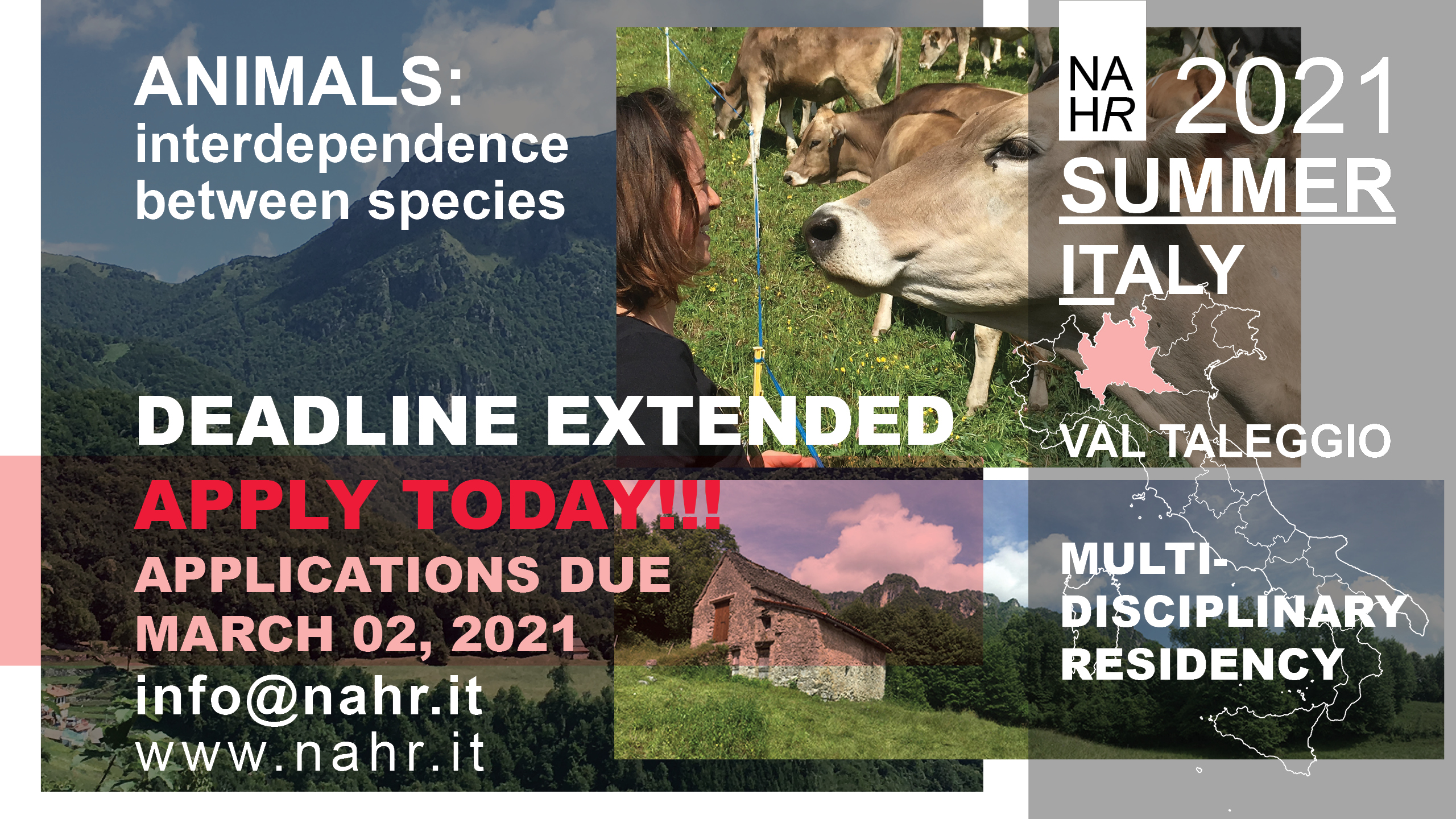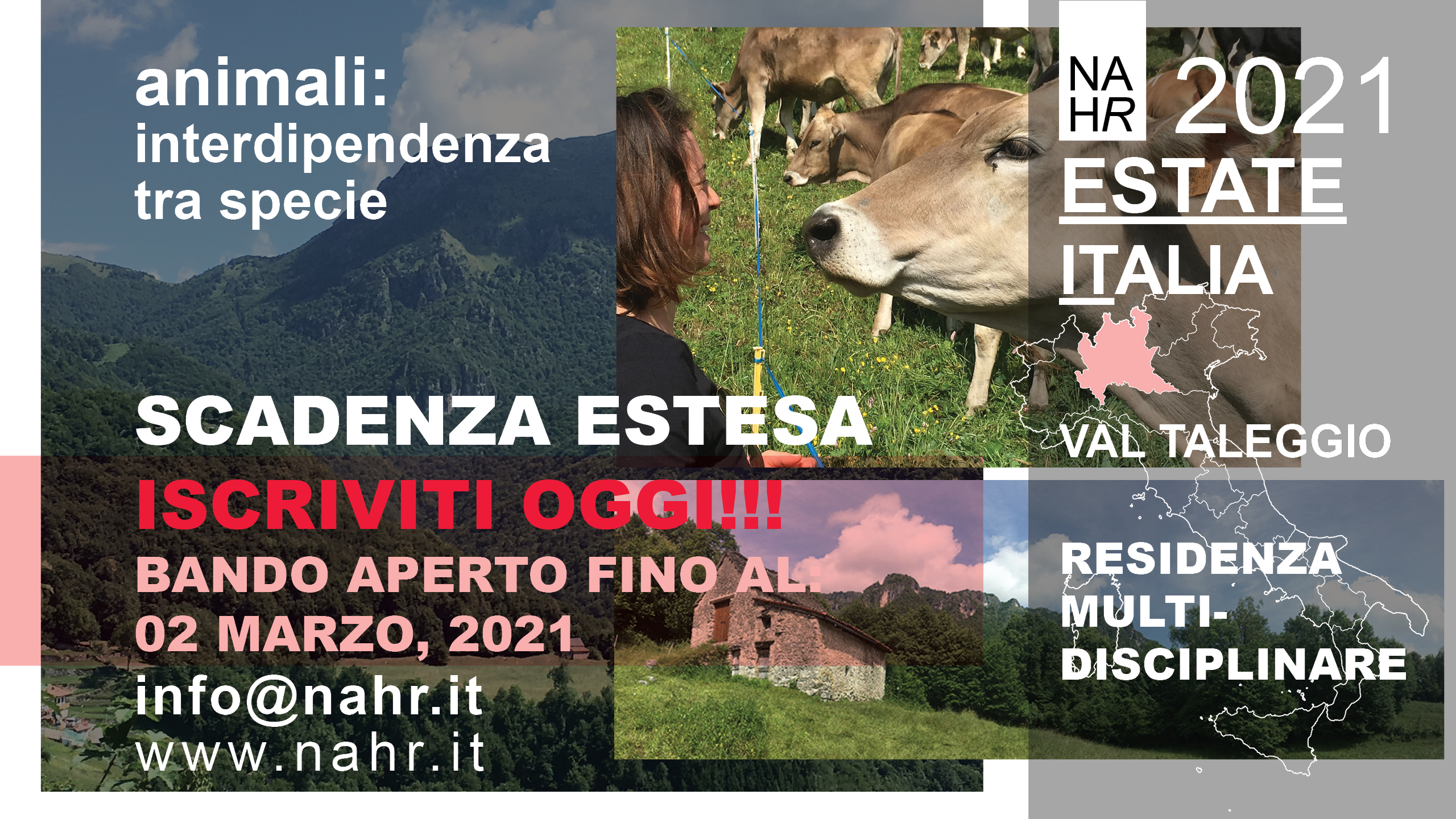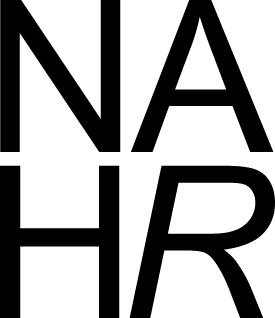NAH_Residency / NAH_Residenza





2021
ANIMALS: Interdependence Between Species
NAHR_Italy - OPEN NOW
2 Residencies are offered:
June 2021
ALT RES July or August 2021
NAHR June 2021
ALT RES 2021: rolling and accepted until spaces are available.
APPLY (no application fees!)
NAH_WORKSHOP 2021
VISION NAHR 2021
NAHR recognizes that all living organisms depend on each other for survival. This coexistence is at the root of ecological thinking, and holds as paramount the need to fight climate change and save animal species from extinction. NAHR 2020 intends to foster an expanded consciousness of these issues through sensorial and reflective “dialogue.” From this exploration, we believe we can develop a pivotal change in the global approach to Nature, moving away from the hierarchical view that sees humankind as entitled to dominate any other species, and towards a holistic approach where humankind lives in harmony with other species.
Using this emerging framework, Fellows will be encouraged to create artifacts embedded with the transformation from an ego-centric to an eco-centric world view. Projects could focus on the loss of biodiversity, interspecies relations, species vulnerability, conservation efforts, biopolitics, among other topics. Fellows are also encouraged to explore how animals inspire design, architecture, art, music and/or the performing arts.
OUR INTERESTS
Climate change and loss of biodiversity are interconnected. However, the former has been getting most of the attention in recent environmental discourse. NAHR 2020 wants to focus on, and find reasons for, why we should prioritize biodiversity. Perhaps it is because we depend on each other!
The visible effects of human impact on climate change, and the mounting loss of biodiversity around the globe, has generated renewed interest in resilient, bio-inclusive solutions to reversing the climate crisis. We think that these solutions should take into account current lifestyles and aspirations, today’s unprecedented technological advancements, and be informed by historical precedents for interspecies coexistence. Doing so allows our explorations to range in scale from micro to macro biomes. We also give ourselves the opportunity to learn from the past.
Aligned with the objectives of the convention on biodiversity from Rio 1992, which still have not been adequately realized, NAHR 2020 offers an eco-laboratory to Fellows interested in developing strategies to rebalance and redesign the relationships between species.
OUR HABITAT, THE VALLEY
The Taleggio Valley landscape in the foothills of the Alps in northern Italy, with its dramatic scenery and secluded physical environment, will serve as a rich source of inspiration for ideas, and a fertile ground for bio-inspired projects to flourish.
The Valley’s own biodiversity supports a habitat for hundreds of species, both wild and domesticated, in the waters, soil and air. The landscape shows distinct and varied features at different elevations, from the bottom of ravines to the mountain pastures of the Parco delle Orobie. Micro-animals (microorganisms and microbes) and invertebrates (insects, shellfish, worms, and spiders), fish, reptiles, birds, and mammals can all be readily observed, serving as inspiration for creative inquiry.
Its villages and towns, all in close proximity, offer many opportunities to observe and study the ‘built’ environment of both natural and artificial constructions, and their alteration over the years, as human and non-human strategies of habitation shifted to adapt to ever-changing environmental, economic, and social factors. Bird’s nests, roccoli (hunting towers), spider-webs, burrows, and farms are examples of some of the many features that promise to inspire sympathetic thinking, design responses, and other fabrications during the residency.
We believe human perceptions of the world are enhanced by exploring the mechanisms other species have developed for sensing, mapping, and moving through the same territories as humans. As all senses are engaged in an exploration of the Valley’s living eco-laboratory, one starts to perceive the world differently. The residency ultimately pursues the notion that this shift in perception is the key for creative resilience, the mechanism that allows ecosystems to create a sustainable life through adaptation and cooperation.
OUR QUESTIONS
NAHR aims to support the development and sharing of bio-inspired projects, ignite conversations, and spark possible future collaborative research. With this in mind, the following are some initiating thoughts for applicants:
1. Questions on Coexistence:
· In what ways can we envision a post human-centered world in which all living organisms could coexist? How can we interpret this quote from Giorgio Agamben(4): “…the relations between animals and men will take on a new form, and man himself will be reconciled with his animal nature.’’
· How does the rise of smart technologies like A.I. fit in to a vision of coexistence?
2. Questions About Interspecies Boundaries:
· How do we define boundaries between species that depend on each other? How do we understand these boundaries in historical, cultural and biological contexts?
· Does the vulnerability of some species translate to vulnerabilities of all species?
3. Questions About Scale and Perception, or the Senses:
· How does the size of an organism influence humankind’s perception of its relevance or value?
· How can we develop our ability to interact with the non-human in non-visual ways, and what are the benefits of this?
· Can sensing the world like an animal help foster new kinds of relationships between species?
4. Questions About Making and Building:
· Can we learn to build in a manner more attuned to the environment by observing burrows, webs, nests, etc.?
· How do non-human animal buildings and methods of making contribute to their survival, and to their thriving?
PROPOSALS
NAHR encourages experimental explorations based on globally relevant concepts, theories or methodologies about interspecies coexistence and post-anthropocentric thinking as their fundamental framework. Collaboration across disciplines, with other NAHR Fellows, is particularly encouraged and supported. These explorations can be done using a variety of media, and will be shared at the conclusion of NAHR in expressive forms including, but not limited to: dance performances, poetry recitations, promenade theatre presentations, art installations, site-specific activations, and other creative products.
Given the immersive, site-specific context for NAHR, when drafting submissions applicants must demonstrate the ways in which their projects will seek to engage with Val Taleggio as a shifting, multi-dimensional space in which local characteristics intersect a global dynamic. Applicants should show how they intend to examine elements and ecosystems within the Val Taleggio, while scaling or linking their subjects to globally relevant concepts.
In accordance with this year’s theme, NAHR encourages applications that propose an inter- or trans-disciplinary approach across a range of creative forms and modes of expression, which might take the form of designs, actions, events, and so forth, in which the use of the ecosystem of the Valley will remain a key element of the proposal. Projects proposing observance of animals in their habitat with all its elements, including both natural and humanly-altered states, are especially encouraged.
Together with the NAHW (Workshop), NAHR (Residency) participants will visit high and low pastures, walk across the mountains, attend dedicated lectures by specialists in the area, and be guided across the surrounding landscapes (natural and built), in order to explore local interconnections and contrast these with those in the neighboring valleys of Brembilla, Brembana, Seriana and Imagna. By offering the opportunity for site-specific investigations, NAHR encourages participants to explore interactions and relationships within the Valley’s ecosystems. We seek to offer a fertile environment for a range of cross-disciplinary research and, in return for offering these opportunities, we expect NAHR Fellows to complete culminating presentations (designs, actions, events, so forth) at the conclusion of their time in the Val Taleggio.
references:
(1) (2) https://www.upress.umn.edu/book-division/books/when-species-meet
(3) https://www.un.org/en/events/biodiversityday/convention.shtml
(4) Giorgio Agamben, The Open. Man and Animal, 2004
(5) http://sdg.iisd.org/events/2020-un-biodiversity-conference/?fbclid=IwAR1ktcfr4qFt7GbOBzD3HORhgJ7iQ0wdH02pg4FfMNFDl6a6EpUjx6y0Rug
APPLY (all details at this link)
NAH_CA_R
NAHR California Spring 2021 - CLOSED
All living organisms depend on each other for survival. This coexistence is at the root of ecological thinking and holds as paramount the need to end climate change and save animal species from extinction. NAH_CA_R 2021 is established to foster an expanded consciousness of these issues through sensorial and reflective “dialogue”.
Using this framework, the California residency is an opportunity for a creative retreat where the chosen Fellow can produce a response to the transformation from an ego-centric to an eco-centric world view. Projects could focus on the global discourse on the loss of biodiversity, interspecies relations, species vulnerability, conservation efforts, or biopolitics, among other topics. Fellows are encouraged to explore Animals: Interdependence Between Species as it relates to their field: design, architecture, science, technology, economics, visual art, music, and/or the performing arts.
This Residency is connected to NAHR in Italy, and we suggest the applicant also refer to the full text of the NAHR call for submission for the Italian residency: here below.
Time Frame for the Residency
This is the initiation of a California NAH_Residency, and it will be a two to three-week retreat in the spring of 2021, depending on the proposal. The residency will be initiated with a public dialogue with the NAHR community from around the world, and will culminate with a display that will be both in person and digital, with a final discourse and presentation by the Fellow. The first residency will be in March or April of 2021, with flexibility on the dates to accommodate the selected Fellow. It will start on a Sunday and conclude on a Saturday.
Settings and Accommodation see here
APPLY (no application fees!)
2020
NAH_Remote: COEXISTENCE
Virtual program:
Recorded Workshops and submitted Reflections
can be seen here
2021
ANIMALI: Interdipendenza tra Specie
NAHR_Italia - BANDI APERTI
2 Residenze sono offerte:
Giugno 2021
ALT RES Luglio o Agosto 2021
NAHR Giugno 2021
ALT RES 2021: domande accettate fino a disponibilita’ raggiunta.
ISCRIVITI (l’iscrizione e’ gratuita)
NAHW_Seminario 2021
VISIONE NAHR 2021
NAHR riconosce che tutti gli organismi viventi dipendono l'uno dall'altro per sopravvivere. Questa convivenza è alla base del pensiero ecologico e tiene in primo piano la necessità di combattere i cambiamenti climatici e salvare le specie animali dall'estinzione. NAHR 2020 intende promuovere una coscienza espansa, abbracciando questi problemi attraverso un "dialogo" sensoriale e riflessivo. Da questa esplorazione, riteniamo di poter sviluppare un cambiamento fondamentale nell'approccio globale alla Natura, allontanandoci dalla visione gerarchica, che vede l'umanità come autorizzata a dominare qualsiasi altra specie, e verso un approccio olistico in cui l'umanità vive in armonia con altre specie.
Adeguandosi al contesto di indagine emerso, i Residenti saranno incoraggiati a creare artefatti volti alla trasformazione di una visione del mondo incentrata sull'ego, in una visione eco-centrica. I progetti potrannno concentrarsi su: perdita di biodiversità, relazioni interspecie, vulnerabilità delle specie, sforzi di conservazione, biopolitica, tra gli altri argomenti. I Residenti sono incoraggiati ad esplorare oltresi’ come gli animali possono ispirare il progetto creativo: design, architettura, arte, musica e / o arti dello spettacolo.
INTERESSI
I cambiamenti climatici e la perdita di biodiversità sono interconnessi. Tuttavia, il primo ha ricevuto la maggior parte dell'attenzione nel recente discorso ambientale. NAHR 2020 vuole concentrarsi e trovare ragioni per cui dovremmo dare la priorità anche al tema della biodiversità, perché dipendiamo gli uni dagli altri!
Gli effetti visibili dell'impatto umano sui cambiamenti climatici e la crescente perdita di biodiversità in tutto il mondo, hanno generato un rinnovato interesse per soluzioni resilienti e bio-inclusive per invertire la crisi climatica. Riteniamo che queste soluzioni debbano tenere conto degli stili di vita e delle aspirazioni attuali, dei progressi tecnologici, e di essere informati da precedenti storici per la coesistenza interspecie, dandosi anche l'opportunità di imparare dal passato. Ciò consente alle nostre esplorazioni di spaziare in scala dal micro al macro bioma.
Allineato con gli obiettivi della convenzione sulla biodiversità di Rio 1992, che non sono ancora stati adeguatamente realizzati, NAHR 2020 offre un eco-laboratorio a chi interessato a sviluppare strategie per riequilibrare e ridisegnare le relazioni tra le specie.
HABITAT, LA VALLE
Il paesaggio della Val Taleggio, nelle Prealpi Orobie Bergamasche, con i suoi scenari emozionanti e l'ambiente fisico appartato, servirà come ricca fonte di ispirazione per le idee, e un terreno fertile per far prosperare progetti bio-ispirati.
La biodiversità della Valle costituisce un habitat per centinaia di specie, sia selvatiche che domestiche, nelle acque, nel suolo e nell'aria. Il paesaggio mostra caratteristiche distinte e varie a diverse quote, dal fondo dei burroni agli alpeggi del Parco delle Orobie. Micro-animali (microrganismi e microbi) e invertebrati (insetti, molluschi, vermi e ragni), pesci, rettili, uccelli e mammiferi possono essere tutti facilmente osservati, servendo come ispirazione per l'indagine creativa.
I suoi villaggi e le sue città, a poca distanza gli uni dalle altre, offrono molte opportunità di osservare e studiare l'ambiente "costruito", fatto di strutture sia naturali che artificiali, e la loro alterazione nel corso degli anni, poiché le strategie di abitazione umane e non umane si modificano in continuazione a seguito del fenomeno dell’adattamento -conseguente al mutamento di fattori ambientali, economici e sociali. Nidi di uccelli, roccoli (torri di caccia), ragnatele, tane e fattorie sono esempi di alcune delle molte costruzioni che promettono di ispirare il pensiero simpatetico, le risposte di progettazione e altre strutture durante la residenza.
Crediamo che le percezioni umane sul mondo siano migliorate esplorando i meccanismi che altre specie hanno sviluppato per rilevare, mappare e muoversi attraverso gli stessi territori degli umani. Dato che tutti i sensi sono impegnati in un'esplorazione del laboratorio ecologico vivente della Valle, si inizia a percepire il mondo in modo diverso. La residenza persegue infine l'idea che questo cambiamento nella percezione sia la chiave per la resilienza creativa, il meccanismo che consente agli ecosistemi di creare una vita sostenibile attraverso l'adattamento e la cooperazione.
LE DOMANDE
NAHR mira a sostenere lo sviluppo e la condivisione di progetti bio-ispirati, innescare conversazioni e stimolare possibili ricerche e collaborazioni future. Con questo in mente, di seguito sono riportati alcuni stimoli iniziali per i candidati:
1. Domande sulla coesistenza:
• In che modo possiamo immaginare un mondo post-umanocentrico in cui tutti gli organismi viventi possano coesistere? Come possiamo interpretare questa citazione di Giorgio Agamben(4): "... le relazioni tra animali e uomini assumeranno una nuova forma e l'uomo stesso si riconcilierà con la sua natura animale"?
• In che modo l'ascesa di tecnologie intelligenti come A.I. possono adattarsi a una visione di convivenza?
2. Domande sui confini di Interspecie:
• Come definiamo i confini tra le specie che dipendono l'una dall'altra? Come possiamo comprendere questi confini in contesti storici, culturali e biologici?
• La vulnerabilità di alcune specie si traduce in vulnerabilità di tutte le specie?
3. Domande sulla percezione delle dimensioni, sulla scalarità, o sui sensi:
• In che modo la dimensione di un organismo influenza la percezione dell'umanità della sua rilevanza o valore?
• Come possiamo sviluppare la nostra capacità di interagire con il non umano in modo non visivo, quali sono i vantaggi di questo?
• Rilevare il mondo come fanno gli animali può favorire nuovi tipi di relazioni tra le specie?
4. Domande sul fare e costruire:
• Possiamo imparare a costruire in un modo più adeguato all'ambiente osservando tane, ragnatele, nidi, ecc.?
• In che modo le costruzioni di animali non umani e le tecniche utilizzate possono contribuire alla loro sopravvivenza e alla loro prosperità?
PROPOSTE
NAHR incoraggia esplorazioni sperimentali basate su concetti, teorie o metodologie rilevanti a livello globale sulla coesistenza interspecie e sul pensiero post-antropocentrico come quadro fondamentale. La collaborazione tra discipline, con altri membri di NAHR, è particolarmente incoraggiata e supportata. Queste esplorazioni possono essere fatte utilizzando differenti media e saranno condivise alla conclusione di NAHR in forme espressive tra cui, a titolo esemplificativo ma non esaustivo: spettacoli di danza, recitazioni di poesie, installazioni artistiche, attivazioni site-specific e altri prodotti creativi.
Data l’importanza che ha per NAHR il contesto, coinvolgente e specifico, quando si elaborano le proposte i candidati devono dimostrare i modi in cui i loro progetti cercheranno di interagire con la Val Taleggio come uno spazio mutevole e multidimensionale in cui le caratteristiche locali si intersecano con una dinamica globale. I candidati devono mostrare come intendono esaminare elementi ed ecosistemi all'interno della Val Taleggio, ridimensionando o collegando i loro soggetti a concetti rilevanti a livello globale.
In linea con il tema di quest'anno, NAHR incoraggia le applicazioni che propongono un approccio interdisciplinare o transdisciplinare attraverso una gamma di forme e modalità espressive creative, che potrebbero assumere la forma di disegni, azioni, eventi e così via, in cui l'uso dell'ecosistema della Valle rimarrà un elemento chiave della proposta. I progetti che propongono l'osservazione degli animali nel loro habitat con tutti i suoi elementi, compresi gli stati naturali e quelli umanamente modificati, sono particolarmente incoraggiati.
Insieme a NAHW (Workshop), i partecipanti a NAHR (Residency) visiteranno pascoli alti e bassi, cammineranno sulle montagne, parteciperanno a lezioni tenute da specialisti dell'area e saranno guidati attraverso i paesaggi circostanti (naturali e costruiti), al fine di esplorare le interconnessioni locali e confrontarle con quelle delle valli limitrofe, come la Val Brembilla, Brembana, Seriana e Imagna. Offrendo l'opportunità di investigazioni specifiche per sito, NAHR incoraggia i partecipanti a esplorare le interazioni e le relazioni all'interno degli ecosistemi delle vallate.
Cerchiamo di offrire un ambiente fertile per una serie di ricerche interdisciplinari e, in cambio dell’offerta di queste opportunità, ci aspettiamo che i NAHR Fellows completino le loro elaborazioni (progetti, azioni, eventi, ecc.) e le presentino al termine del loro tempo in Val Taleggio.
references:
(1) (2) https://www.upress.umn.edu/book-division/books/when-species-meet
(3) https://www.un.org/en/events/biodiversityday/convention.shtml
(4) Giorgio Agamben, The Open. Man and Animal, 2004
(5) http://sdg.iisd.org/events/2020-un-biodiversity-conference/?fbclid=IwAR1ktcfr4qFt7GbOBzD3HORhgJ7iQ0wdH02pg4FfMNFDl6a6EpUjx6y0Rug
ISCRIVITI
NAH_CA_R
NAHR California Primavera 2021 - Chiusa
Vedi testo in inglese
